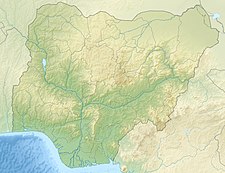The Great Mosque of Kano (Arabic: الجامع الكبير في كانو) is a general Jumaat mosque in Kano, the capital city of Kano State and the second most populous city in Nigeria. The mosque is situated at around the Heart of the city around the Mandawari area of the state.
| Great Mosque of Kano | |
|---|---|
الجامع الكبير في كانو | |
 The Kano central mosque in 1960. Taken by Dr. Mary Gillham | |
| Religion | |
| Affiliation | Sunni |
| Status | Active |
| Location | |
| Location | Kano, Kano state |
| Country | Nigeria |
| Administration | Emirate Council |
| Geographic coordinates | 11°59′41″N 8°31′03″E / 11.99472°N 8.51750°E |
| Architecture | |
| Type | Mosque |
| Founder | Muhammad Rumfa |
| Date established | 15th century |
| Specifications | |
| Dome(s) | 7 |
| Minaret(s) | 2 |
| Minaret height | 20 Meters |
History
editThe great mosque of Kano is the oldest mosque in Nigeria and was built for Muhammad Rumfa in the 15th-century. It was made of mud, and was of the soro, or tower, variety.[1][2] Prior to Rumfa's reign and conversion to Islam, the central mosque of Kano was located in two possible locations. The first possibility is the Sharifai quarter, inhabited by the descendants of the 15th-century Berber scholar al-Maghili. The second possibility is the Yan Doya quarter, inhabited by Wangara muslims from the Mali empire.[3]
It was moved to a new site by Muhammad Zaki in 1582, and rebuilt in the mid 19th century by Abdullahi Dan Dabo. After the Sokoto jihad, Emir Suleiman, who was regarded as the Imam of Kano, led Friday prayers himself in the mosque. Subsequent emirs have delegated the authority to an appointed Imam.[4]: 226–227
It was destroyed in the 1950s, and rebuilt with British sponsorship.[1]
1980 Kano riot
editIn December 1980, adherents of Maitatsine, known as Yan Tatsine, launched an assault on the mosque's attendees during Friday prayers in an attempt to seize control of the mosque. The conflict persisted for eleven days, initially engaging with the police and later escalating to involve the army. The intense confrontation concluded only after Maitatsine and his followers, who were defending their headquarters, were killed. The officially reported death toll surpassed 4,000, although other sources indicate a higher toll.[5][6]: 109
See also
editReferences
edit- ^ a b "Great Mosque of Kano". ArchNet. Massachusetts Institute of Technology. Archived from the original on 2005-05-14. Retrieved 2007-07-13.
- ^ Walker, Bethany J.; Insoll, Timothy; Fenwick, Corisande (eds.). The Oxford Handbook of Islamic Archaeology. Oxford University Press. p. 498.
- ^ African urban spaces in historical perspective. Rochester: University of Rochester Press. 2005. p. 11. ISBN 978-1-58046-637-0.
- ^ Paden, John N. (1973). Religion and political culture in Kano. Berkeley: University of California Press. ISBN 978-0-520-01738-2.
- ^ Dash, Leon (1982-12-17). "Nigerian Moslem Sect Uprising Killed Hundreds". Washington Post. ISSN 0190-8286. Retrieved 2023-11-11.
- ^ Islam in the modern world. New York: St. Martin's Press. 1983. ISBN 978-0-312-43740-4.
External links
edit
